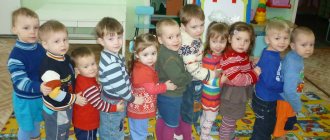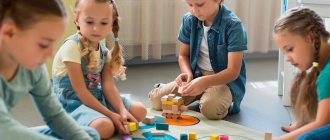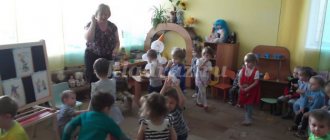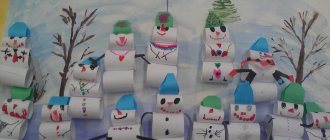THEMATIC PLANNING FOR FCCM FOR THE JUNIOR GROUP OF KINDERGARTEN
Comprehensive thematic planning for FCCM
Source:
1. M. V. Karpeeva Formation of a holistic picture of the world. Cognitive and informational part, gaming technologies. Second junior group.
2. O. A. Solomennikova Introduction to nature in kindergarten. Junior group
SEPTEMBER
1-2 week monitoring
№1
Toys
Clarify and expand children's vocabulary on the topic. Introduce them to the general concept of “toys”. Form the concept of “big-small”. Learn to form diminutive nouns. Development of fine motor skills, logical thinking, holistic perception of the subject. Foster a caring attitude towards toys, mutual assistance, and a desire to work.
A chest with toys (car, dolls, ball, nesting dolls, etc.), two baskets (boxes), pictures of toys or toys, pictures cut into two parts.
1- p.4
№2
Autumn
Introduce children to the main signs of autumn. Clarify and expand their vocabulary on the topic. Reinforce the concept of “one-many”. Reinforce the concepts of “red color”, “yellow color”. Develop their attention, memory, thinking. To develop the ability to notice the beauty of autumn nature.
A clock showing the seasons, a painting “Autumn”, a ball,
1-s. 9
OCTOBER
№3
Vegetables
Introduce children to the general concept of “vegetables”. Clarify and expand their vocabulary on the topic. Introduce children to where vegetables grow. Learn to form the plural of nouns. Development of general motor skills. Development of memory and thinking. To cultivate a caring and loving attitude towards nature, which has generously endowed us with its riches.
A picture depicting a vegetable garden, beds, a basket of vegetables, a ball, a toy hare, a bag, vegetables or their dummies, a pair of pictures depicting a large and a small vegetable. pictures depicting the same vegetable of different sizes (3-4 pieces).
1- p.15
2-s. 25
№4
Fruits
Clarify and activate children's vocabulary on the topic. Introduce them to the general concept of “fruit”. Learn to select signs for an object. Learn to name colors. To develop the ability to form the plural of nouns. Develop gross and fine motor skills. Develop gross and fine motor skills. Develop speech, thinking, memory. Cultivate the habit of helping others, being active, attentive and responsive when interacting with each other.
Painting “In the Garden”, replicas of fruits, various objects. Big and small apple (models, pictures). Pictures depicting one and two fruits.
1-s. 21
№5
Trees
Clarify and expand children's vocabulary on the topic. Introduce the aging of wood and the names of its main parts. Development of general and fine motor skills, development of attention, memory, thinking. Development of phonemic hearing. Cultivate a caring attitude towards trees and nature.
Ball, “Tree” manual, multi-colored leaves are attached to strings. A picture of a tree, a toy or a cut out picture of a bird. Cards with the image of 4 Christmas trees. Painting "Forest".
1- p. 27
2-s. 42
№6
Mushrooms. Berries.
Clarify and expand children's vocabulary on the topic. Introduce children to the structure of a mushroom and the names of wild berries. Teach them to count within three. Fix the signs of autumn in their memory. Develop children's thinking, memory, attention. Foster a caring attitude towards the forest.
Manual "Mushrooms in the meadow." Mushrooms in three sizes. laces cut out of cardboard with holes for stringing. Dummies or mushrooms cut out of cardboard vary in size.
1- p. 33
№7
Toiletries
Introduce toiletries and their purpose. Bring children to understand the direct dependence of health on cleanliness. Enrich and activate their vocabulary. To instill in children neatness and the ability to take care of their appearance.
Pictures depicting a mouth with teeth, a dirty face, an uncombed girl, a child at a table, a toothbrush, soap, a comb, a glass, etc.. Ball.
1- p. 39
NOVEMBER
№8
Pets
Give children an idea about pets and the benefits they bring to people. Introduce them to the general concept of “pets”. Develop fine and gross motor skills. Develop their phonemic hearing, memory, and thinking. To cultivate a love for pets and their importance in a person’s life.
Toy pets, jar, box. basket. Ball. Pictures with pets. Shadows of pets.
1-s. 46
2-s. 35
№9
Wild animals
Clarify and expand children's vocabulary on the topic. Introduce them to the general concept of “wild animals”. Form an idea of the habitats of wild animals. Develop gross and fine motor skills. Develop memory and thinking. Cultivate interest in living nature, emotional responsiveness.
Painting "Animal Farm". Manual "Wild Animals". Pictures depicting wild animals and their “houses”.
1- p.52
№10
Cloth
Clarify and activate children's vocabulary on the topic. To form their ideas about the general concept of “clothing”. Learn to compare the clothes of boys and girls. Learn to answer in simple sentences. Develop voice power. Develop logical thinking. Develop gross motor skills. Cultivate cognitive interest in children.
Flannelograph with a paper doll. Pictures of clothes, colorful mugs. Ball. Pairs of clothing items.
1- p. 58
№11
Winter
Give children an idea of the season “winter”, introduce them to the signs of winter. Develop speech breathing, general and fine motor skills. Learn to agree nouns with adjectives. Foster love and respect for our native nature.
Painting “Winter”, mittens on which a snowflake is attached on a string. Ball, three white circles of different sizes. A set of pictures depicting summer and winter clothes. A picture depicting a blizzard, blizzard. A set of pictures with signs of winter, two pictures with signs of summer, two pictures with signs of autumn.
1- p.64
DECEMBER
№12
Wintering birds
Introduce children to wintering birds. To form their understanding of the general concept of “wintering birds”. Introduce children to the structure of birds. Learn to understand prepositional constructions and use the prepositions “on” and “with” in speech. Develop fine and gross motor skills. Develop thinking, memory, attention. Cultivate a caring attitude towards birds in winter.
Manual "Bird Feeder". Feeder, pictures of birds. Individual pictures of birds, feature. Pictures depicting wintering birds.
1-s. 68
2-s. 32
№13
Poultry
Expand and clarify children's vocabulary on the topic. To form their ideas about the general concept of “poultry”. Introduce children to poultry chicks. Develop gross motor skills. Develop thinking, observation, memory. Cultivate in children a kind attitude towards pets.
Paired pictures depicting poultry and their chicks. Toy poultry. Ball. Paired pictures with the image of an egg.
1-s. 74
№14
New Year holiday
Clarify and expand children's vocabulary on the topic “New Year”. To form their ideas about the general concept of “New Year’s toys”, “Christmas tree toys”. Learn to compose a simple common phrase with the preposition “on” and without a preposition. Learn to accompany your actions with speech. Develop memory, thinking, attention. Foster collectivism and friendly relations among each other.
Paired pictures depicting Christmas tree decorations. Pouch. Balls of thread of different colors, scissors, Christmas tree on flannelgraph. A picture of Santa Claus on a sleigh, a bell and bells, large and small bells. Cards with pictures for each child or cards with pictures of objects.
1-p.79
№15
Winter. Winter fun
Expand children's vocabulary on the topic. Develop their speech hearing. Learn to distinguish between long and short sounds produced by the voice. Learn to understand and use the adjectives “long” and “short”. Learn to understand and use the numerals “one”, “many”. Learn to understand the meaning of nouns formed using diminutive suffixes. Foster a love for the nature of your native land.
Ball. Two pictures with snowmen that have differences. Paired pictures depicting skis and skates. snowmen. spatulas, mittens.
1-s. 85
2-s. 34
JANUARY
№16
Transport
Expand children's knowledge about the world around them. Introduce parts of a truck. Learn to understand sentences with prepositional constructions. To form their ideas about the general concept of “transport”. Develop their attention, memory, thinking, fine and gross motor skills. Cultivate goodwill. Foster a culture of behavior in public transport.
Pictures depicting large and small steamers. Ball. Pictures depicting several types of vehicles. Paired pictures depicting different types of vehicles. medallions around the neck depicting a car in four colors, steering wheels, four pictures depicting garages in four colors.
1-s. 91
№17
House and its parts
Expand children's vocabulary on the topic, introduce them to the names of parts of the house. Keep the score within four. Develop memory, thinking, attention. Form the prosodic side of speech. Cultivate love, a feeling of attachment to one’s home, village.
Parts of the house, flannelgraph. Pictures of houses, toys. Pictures depicting houses of different heights, for each child, pencils. Ball.
1-s. 98
№18
Furniture
Expand children's vocabulary on the topic. To form their understanding of the general concept of “furniture”. Introduce children to the names of the parts of a chair. Give an idea of the functional purpose of furniture. Keep the score within four. Develop memory, thinking, attention. Develop gross and fine motor skills. Cultivate interest in the activity, the desire to learn something new.
Ball. Toys, table, chair. Pictures depicting a room with furniture; various objects lie on the furniture. Pictures depicting pieces of furniture.
1-s. 102
FEBRUARY
№19
Houseplants
Introduce children to the concept of “houseplants”. Introduce the plants “violet” and “ficus”. Introduce the structure of plants and their growth conditions. Develop gross motor skills. Develop thinking, memory, attention. Foster a caring attitude towards indoor plants and a desire to grow them.
Pots and saucers cut out of cardboard are different in color. Sample of a flower in a pot, blanks, flower details from geometric shapes. A picture of a pot, divided into two parts, in different projections.
1-s. 108
2-s. 37
№20
Defender of the Fatherland Day
To form children's understanding of the Defender of the Fatherland Day holiday, to give initial ideas about the Russian army, the branches of the military and some of their representatives: a tankman, a pilot, a sailor. Teach children to convert singular nouns into plural forms. Learn to answer in complete sentences. Develop gross and fine motor skills. Develop their attention, memory, thinking. To foster a sense of pride in one’s army, to instill a desire to be like strong, brave warriors, love for the Motherland, for loved ones, to cultivate kindness and the ability to make friends.
Ball. Pictures depicting military equipment.
1-s. 112
№21
Shoes
Expand and clarify children's knowledge about shoes. To form their understanding of the general concept of “shoes”. Introduce the purpose of shoes, explain the concept of a “pair of shoes.” Continue learning to answer questions with a phrase of 2-3 words. Reinforce knowledge about flowers. Development of general and fine motor skills. Development of their thinking, memory, attention. To instill in children neatness and respect for their clothing.
Pictures depicting shoes and other items. A picture of a pot, divided into two parts in different projections. Pictures depicting the signs of the seasons.
1-s. 115
№22
Spring
Introduce children to the signs of spring. Reinforce their understanding of the seasons. Develop gross motor skills. Learn to answer in complete sentences. Build sensory skills. Development of attention, memory, thinking. To cultivate a caring attitude towards nature, the ability to notice the beauty of spring nature.
Pictures depicting the signs of the seasons. Ball. Pictures of baby wild animals.
1-s. 120
2-s. 39
MARCH
№23
Day March 8
Give children an idea of the holiday on March 8th. Strengthen their knowledge about mom's name. Develop a desire to help mom. Learn to answer in complete sentences. Expand your vocabulary with verbs. Develop gross and fine motor skills. Build sensory skills. Develop attention, memory, thinking. To cultivate love and respect for mothers, grandmothers, and girls.
Pictures depicting a gift in red, yellow, blue, green, orange colors. Ball. Pictures depicting household items. A picture of a bouquet of flowers.
1-s. 124
№24
Dishes
Expand your vocabulary on the topic. To form their understanding of the general concept of “dishes”. Expand children's knowledge about the functional purpose of dishes. Learn to name the parts of utensils. Develop prosodic components of speech. Develop memory, thinking, attention. Develop gross motor skills. Cultivate a caring attitude towards utensils.
Ball. Pictures depicting utensils. One elastic band 15-20 cm long. Pictures depicting a piece of utensils. cut into 3-4 parts. An image of a teapot with missing parts.
1-s. 130
№25
Our body
Give children an idea of the parts of the body and their purpose. Teach children to use nouns in the genitive case in speech. Develop basic types of motor skills, learn to coordinate speech with movement, develop a sense of rhythm. Develop visual and auditory attention, memory, thinking. Develop independence, confidence in your skills, and accuracy.
Ball. Doll. Flat cardboard doll with removable body parts.
1-s. 136
№26
Face
Give children an idea of the parts of the face and their purpose. Learn to form diminutive forms of nouns. Develop basic types of motor skills, learn to coordinate speech with movement. Develop visual and auditory attention, memory, thinking. Develop cultural and hygienic skills.
Small and large doll. A doll with a dirty face.
1-s. 143
APRIL
№27
Pets and their babies
Give children ideas about young domestic animals. Introduce them to the concept of “baby pets.” Expand children's understanding of the structure of animals. Develop fine and gross motor skills. Develop phonemic hearing, memory, thinking. Foster love and respect for animals, a desire to care for them.
Pictures of domestic animals and their babies. Ball. Flannelograph.
1-s. 148
2-s. 29
№28
Wild animals and their babies
Give children ideas about baby wild animals. Introduce them to the concept of “baby wild animals”. Strengthen children's ideas about their habitat. Develop fine and gross motor skills. Develop phonemic hearing, memory, thinking. Cultivate an interest in learning about the world around us. Fostering a kind, caring attitude towards the inhabitants of wildlife.
Pictures of baby wild animals. Pictures depicting forests and wild animal habitats. Ball.
1-s. 153
№29
Family
To clarify children’s ideas about the concept of “family.” Encourage children to talk about their family. Develop basic motor skills. Develop basic motor skills. Develop visual and auditory attention, memory, and form speech hearing. Cultivate love and respect for family and friends.
Benefit "Home". Ball. Pictures depicting family members and various objects. Scene pictures.
1-s. 158
№30
Flowers in the meadow
Introduce children to the characteristic features of wildflowers, their appearance, structure, and places of their growth. Develop physiological breathing. Develop sound pronunciation. Learn to understand prepositional constructions and use the prepositions “on, above, under” in speech. To develop children’s ability to give a complete answer to the question posed. Develop gross motor skills. Develop memory and thinking. Cultivate a caring attitude towards flowers and the ability to take care of them.
Painting with meadow flowers. Pictures with butterflies. beetles. Green pencil and cotton ball.
1-s. 164
№31
Insects
Clarify and expand children's vocabulary on the topic. Introduce them to the concept of “insects” and the structure of insects. Develop the ability to answer teacher questions in complete sentences. Develop speech and physiological breathing. Learn to understand and use prepositional constructions. Develop memory, thinking, motor skills. Cultivate a caring attitude towards all living things.
A painting depicting a clearing, field, forest. Pictures depicting insects and other objects. Pictures of a flower, leaf and insects.
1-s. 169
MAY
№32
Geometric shapes: circle, triangle, square, oval
Strengthen children's knowledge about geometric shapes. To consolidate children's knowledge about the seasons: autumn, winter, spring, and their signs. Strengthen knowledge about insects. Develop fine and gross motor skills. Develop thinking, observation, memory, logic. Develop the ability to listen to the teacher.
1-s. 175
№33
Summer is coming
Clarify and expand children's vocabulary on the topic. Introduce children to the concept of “summer”. To consolidate children's knowledge about the seasons and their signs. Develop gross and fine motor skills. Develop thinking, memory, observation skills. To cultivate a caring attitude towards nature, the ability to notice the beauty of summer nature.
Pictures depicting the seasons. Ball. Pictures depicting signs of summer and other seasons.
1-s. 183
Monitoring
GCD Subject activities and games with composite and dynamic toys
State budgetary educational institution Samara regional basic secondary school No. 21 named after Hero of the Soviet Union E.A. Nikonov of the city of Novokuybyshevsk, urban district Novokuybyshevsk Samara region structural unit "Kindergarten "Terem-Teremok"
Outline of GCD Subject activities and games with composite and dynamic toys
For the first junior group
Theme: “Winter fun”
Prepared by:
teacher of the joint venture “Kindergarten “Terem-Teremok”
Sklyanina O.A.
2019
Plan - outline of educational activities directly
Object activities and games with composite and dynamic toys
For the first junior group
Subject:
"Winter Fun"
Integration of educational areas:
“Speech development”, “Social and communicative development”, “Cognitive development”, “Artistic and aesthetic development”, “Physical development”.
Tasks:
1. Give children basic ideas about winter activities and fun (Cognitive development)
2. Form the rules and skills of cultural behavior during the day and in communication with adults and peers (Socio-communicative development).
3. Develop children’s active speech, enrich their vocabulary, learn new words, teach them to understand adult phrases that are simple in content and construction (Speech development).
4. Development of motor skills, general motor skills, coordination of movements (Physical development)
5. Artistic and aesthetic development (drawing)
Methods and techniques:
Practical – games, exercises, experiments; visual – viewing, observing, viewing; verbal – questions, conversation, situational conversation.
Materials and equipment:
Subject pictures on the topic, “snowballs” made of cotton wool or padding polyester, pictures on the topic, paints, brushes, napkins, glasses of water, easel, sheets of blue paper, onions.
Form of organization of joint activities
| Children's activities | Forms and methods of organizing joint activities |
| Communicative | Conversation, situational conversation |
| Motor | Game exercises |
| Subject activity | games with balls, padding polyester balls |
| Fine | Unconventional painting technique (with bulbs) |
Logic of educational activities
| № | Activities of a teacher | Children's activities |
| 1. | During the walk, the teacher draws the children's attention to the fact that it is winter outside. Everything is covered with snow, the snow is soft, creaks underfoot, you can make snowballs out of it. | They show interest in the walk, listen to the teacher’s speech, participate in observation, look at the snow, touch it, try to make snowballs, and try to answer questions if possible. |





